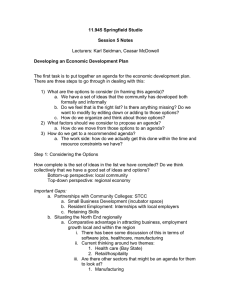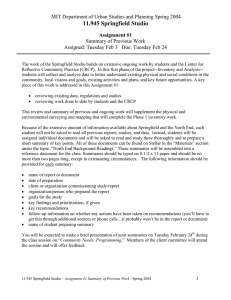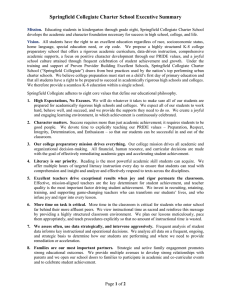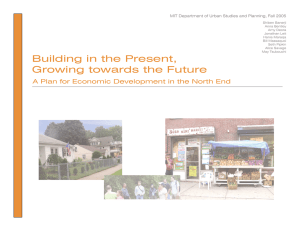11.945 Springfield Studio Session 14 Notes Structuring an Economic Development Strategy
advertisement
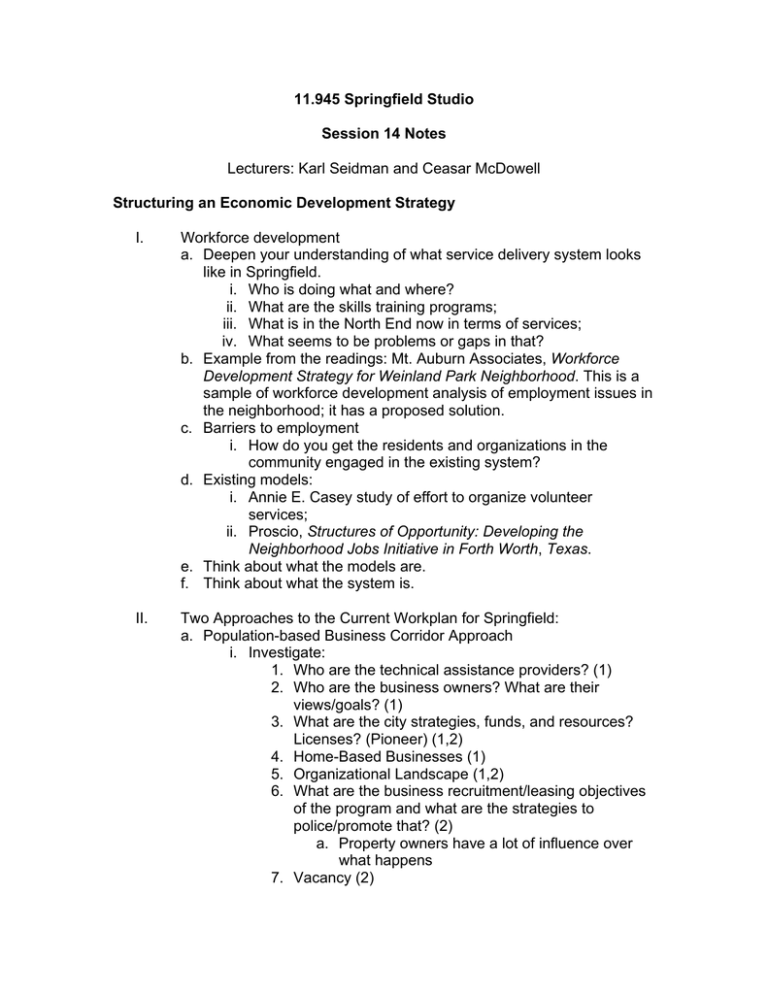
11.945 Springfield Studio Session 14 Notes Lecturers: Karl Seidman and Ceasar McDowell Structuring an Economic Development Strategy I. Workforce development a. Deepen your understanding of what service delivery system looks like in Springfield. i. Who is doing what and where? ii. What are the skills training programs; iii. What is in the North End now in terms of services; iv. What seems to be problems or gaps in that? b. Example from the readings: Mt. Auburn Associates, Workforce Development Strategy for Weinland Park Neighborhood. This is a sample of workforce development analysis of employment issues in the neighborhood; it has a proposed solution. c. Barriers to employment i. How do you get the residents and organizations in the community engaged in the existing system? d. Existing models: i. Annie E. Casey study of effort to organize volunteer services; ii. Proscio, Structures of Opportunity: Developing the Neighborhood Jobs Initiative in Forth Worth, Texas. e. Think about what the models are. f. Think about what the system is. II. Two Approaches to the Current Workplan for Springfield: a. Population-based Business Corridor Approach i. Investigate: 1. Who are the technical assistance providers? (1) 2. Who are the business owners? What are their views/goals? (1) 3. What are the city strategies, funds, and resources? Licenses? (Pioneer) (1,2) 4. Home-Based Businesses (1) 5. Organizational Landscape (1,2) 6. What are the business recruitment/leasing objectives of the program and what are the strategies to police/promote that? (2) a. Property owners have a lot of influence over what happens 7. Vacancy (2) ii. Goals: 1. Link Main Street and local business owners 2. Outline how the community controls the corridor? iii. Competing Visions: 1. NNCC 2. City 3. Baystate 4. Gerena School 5. Community iv. Community Demographics 1. It is a very young community. a. During the last Springfield Practicum, youth were concerned that there weren’t enough businesses and opportunities in the community for them v. What is the work of building a commercial corridor? 1. community organizing 2. reconciling competing visions vi. Working backwards: 1. What do we want this report to do and look like? 2. What do we need to do to accomplish that? 3. Work backward to the work plan 4. Run by the Steering Committee the elements that you think you want to focus on? b. Workforce Development Approach i. Investigate: 1. Spatial disconnect: where residents are versus where training is – barriers (1) 2. What have the elementary/middle school have done to improve high school outcomes? 3. How do we reach different population groups? What are the “splits”? 4. Resident survey and formal discussion with frontline workers 5. Research/summarize different models (Framingham). ii. Goals: 1. Connect North End residents to existing training programs (ESOL, ABE, youth, job specific) 2. Increase resources for local training programs 3. Bring employers into the discussion 4. Identify job ladders (poverty alleviation, living wage) For Tuesday: 1. Each group consolidates summary of their work product/scope/tasks 2. Final review/critique of that on Tuesday.
